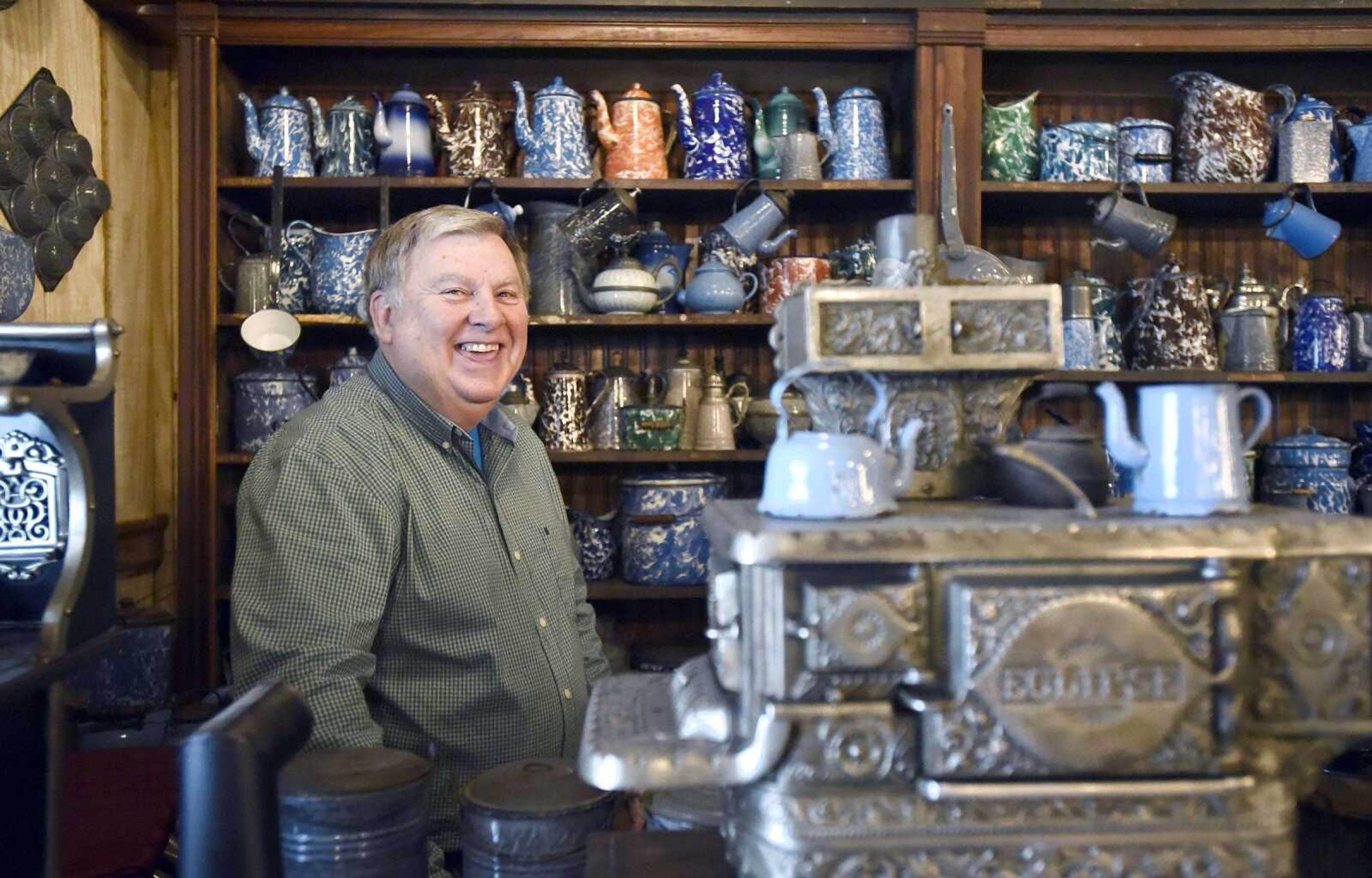Tucked back on a one-lane county road just outside of Gordonville, there's a bright red barn with a handwritten sign taped to the door: "Fat Chance General Store -- Not Open to the Public." Step inside and there's a collection. At first glance it overwhelms, but a closer look reveals intriguing pieces that tell a story of how our region was settled and grew.
Harlan Smothers has been collecting antiques and having sales for a long, long time.
"I started out when I was 10 years old," he said. The first piece he bought was an oil lamp with a glass hurricane.
"I just thought it was beautiful. I liked the old stuff."
What started as a childhood fancy grew with him. He mowed lawns at a dollar apiece, "two if it was a big lawn," and spent his weekends at auctions and estate sales. Smothers said he never had a taste for either beer or cigarettes, but antiques appealed to him, so he spent his money accordingly. His company, Harlan Smothers Estate Liquidation, holds sales either on location or in his country store at 467 Oakshire Drive, about three miles west of Cape Girardeau. He said he's held more than 500 sales in 35 years, one just last weekend, with another scheduled this weekend.

"People think I pick over the sale before I hold it, get all the good stuff for myself, but that's not the case," he said. "You can't do that and expect to do well in this business. I try to do everything ethically, fairly."
He said he doesn't bid if he handles the sale.
"I might ask a friend of mine to bid on something for me, but I offer everything to the public first," Smothers said. "I believe strongly in that."
Smothers displays his pieces in groups, using display cases, shelving and signs originally used in mercantiles and shops.
"Some of the shelves here came from a shop in Carterville, Illinois," he said. He stored them for two years, and, he said, "I finally decided I'd either have to sell the shelves or build myself a shop to put them into."
He decided to build a shop. Last summer, Smothers hired Mennonites from Crowley Ridge Mennonite Church in Stoddard County, Missouri, to do a barn raising. He'd heard for years that they did great work, and put his name on a waiting list to have a barn built.
"It was quite a sight," he said. "We did it the old-fashioned way, you might say. Lifted the walls, teams working together."
The barn has a concrete floor and electrical work done by Smothers' son-in-law, Scot Kluesner. He installed knob-and-tube wiring visible against the ceiling, and built a chandelier out of a wagon wheel and some fruit jars. "I had that wagon wheel out leaning against the barn, and Scot asked if he could make me a chandelier," Smothers said. "Well, I thought that was a great idea, and here it is. He does good work."
For his personal collection, he focuses on pieces made prior to the mid-20th century.
"I've noticed many younger people are more interested in the mid-century stuff," he said. "I don't care for it as much, myself. I was there then. I had to live with it."
He sees more appeal in pieces like the wooden box with a sliding lid. He bought it at least 40 years ago at a sale near Old Saint Francis Hospital in Cape Girardeau. It isn't a large piece, at about 8 inches long, but a date, 1835, is inscribed on one side. On the other is a name, M.L. Heiser.
"Nobody wanted this stuff back then," he said. "They thought it was old junk. I don't think I gave 50 cents for this box, and look, the lid still works. Piece is over a hundred and fifty years old. Can you imagine?"
He said many pieces like this were brought to the region by settlers in the 1800s.
"A lot of times, little stuff like this would be sold by the boxful at auctions," Smothers said. "People wouldn't know what they had their hands on."
He said that's how auctions were handled, years ago.
"Auctioneers would take nickel bids, then dime bids as the years went on," he said. "There are several pieces I could point to in here that I gave less than a dollar for, but I've had them a long time."
The market has changed considerably, too.
"Graniteware used to be a real hot-ticket item," he said, although prices have fallen off in recent years. "But when you look at locally-made stoneware, you're looking at pieces that can bring a lot at a good sale."
He said especially valuable pieces of stoneware can look humble, but their value comes from their origin.
"It can be hard to tell sometimes, but you look for a maker's mark, usually on the bottom or the lower outside," he said. "That can tell you a lot about where a piece was made."
He said there were potters in the Saint Louis area, and that there is a lot of information on the internet. "Collectors form societies," he said, and they can answer questions or point people in a direction for answers.
"Of course, my favorite piece of my collection's my wife, Doris," he said. "But I love old toys, Christmas stuff, too."
In a box in Doris' great-grandmother's attic, he found a Santa that needs some cleaning up.
"I'll use cornmeal to soak up the dirty, greasy stuff," he said. "There's just enough oil in the cornmeal to work on more delicate pieces like this one."
The Mennonites needed to build a box out from the wall for electrical, so he set it up to look like a loading dock you'd see on an old store.
"We used beams from a barn Doris' great-grandfather or maybe great-great-grandfather had hewn by hand," Smothers said. "It's set up with crates and flour sacks, the sort of thing you'd see on a porch or a loading deck 70 years ago."
A sign from Milde's Bottling Co. is on the wall, and a wire egg crate sits next to a wooden neck yoke.
"There were a lot of little shops and manufacturing places here, and they all advertised," he said.
Thermometers and metal matchboxes with company logos and slogans were commonly distributed by businesses. Wooden boxes with the company name also were common.
"That was how people advertised," Smothers said. "I like pieces like that."
Above all, it's important to remember that going to three auctions and a garage sale does not make anyone an authority.
"I've been at it all my life, and I halfway know what I'm looking at," he said.
He doesn't consider himself an expert, but he can recognize pieces that are significant, most times.
"I know when a piece is rare, sometimes," he said. "I try to give people a fair price if I'm buying, and I try to sell for a fair price. There's no reason not to."
Looking at his collection, displayed from floor to ceiling, in cases and shelves, on tables and walls, he said, "I've sold a lot more than I kept, raising three kids and being in business. You can't hold on to everything, but I have managed to squirrel away a few items."
mniederkorn@semissourian.com
(573) 388-3630
Connect with the Southeast Missourian Newsroom:
For corrections to this story or other insights for the editor, click here. To submit a letter to the editor, click here. To learn about the Southeast Missourian’s AI Policy, click here.









